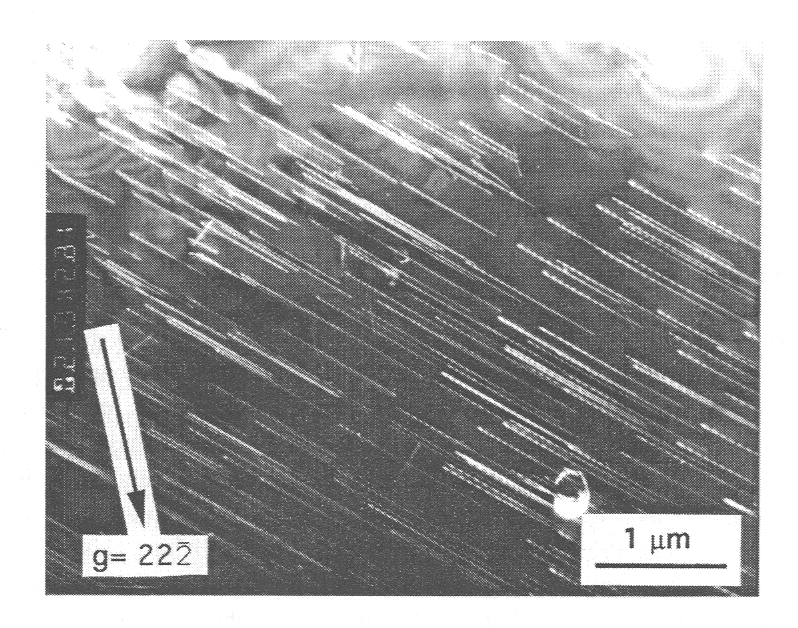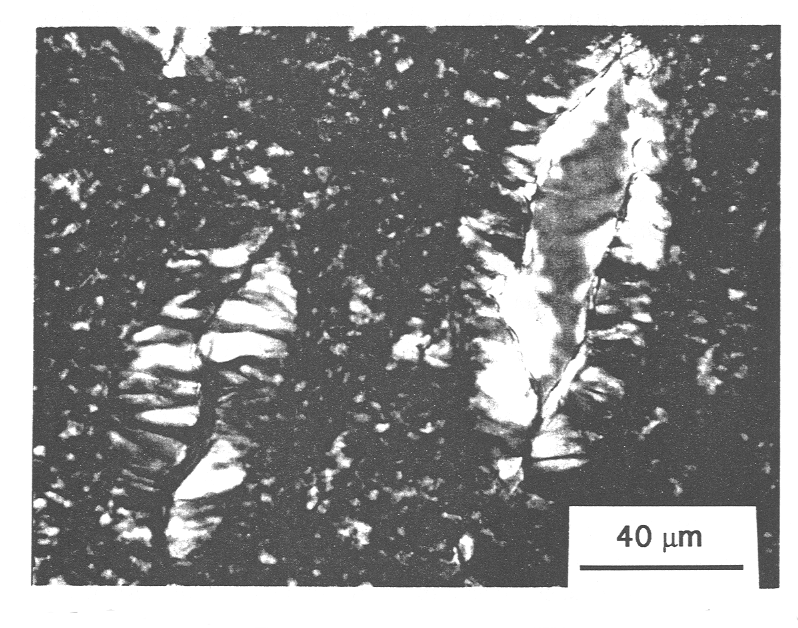

High-pressure phase transformations of olivine within the Earth's upper mantle cause large changes in physical properties such as density, elasticity, and rheology. These changes are especially significant in subduction zones where large lateral variations in temperature are expected to control the depth at which transformations occur. Because high stresses are likely to occur in subducting lithosphere, it is important to investigate deformation of mantle phases and the effects of stress on transformation mechanisms under subduction zone conditions.
To investigate deformation and transformations of olivine at high pressures, we have carried out a series of experiments using a multianvil press as a high-pressure deformation apparatus. The deformation assembly is a simplified version of that used by Bussod et al. (Annual Reports 1992, 1993) for the deformation of olivine single crystals. Our starting material consisted of powdered San Carlos olivine that was hot pressed at 11 GPa and 1250 °C for 2h and then deformed at temperatures and pressures ranging from 600 to 1000 °C and 15 to 18 GPa, respectively. Samples were characterized with transmission electron microscopy to determine the deformation mechanisms and dislocation microstructures as well as transformation mechanisms in partially transformed samples.
Because little is known about the mechanical properties and deformation
mechanisms of olivine at high pressures (stress-strain data are not available
from multianvil experiments) it is important to characterize the defect
microstructures in the deformed olivine. In a sample deformed at 11 GPa
and 1250 °C for 2h, 90 % of the grains are defect free while the remaining
10 % contain dislocations with free-dislocation densities up to 5x1012
m-2. The free dislocations consist of a [100] edge
dislocations and few c [001] screw dislocations. The a edge
dislocations have straight segments (L = [001]) as well as curved
segments, and in some cases occur as loops. We also detected well-organized
pure tilt boundaries (Fig. 3.1-3) parallel to (001). These features indicate
recovery and are consistent with a high temperature deformation mechanism
controlled by dislocation climb. In a sample deformed at the same conditions
and then further deformed at 18 GPa and 600 °C for 30 min, we observe
grains with highly heterogeneous dislocation densities varying from 1011
to 5x1013 m-2, depending on the crystallographic
orientation of each grain relative to the principal stress. The deformed
grains contain mostly straight c screw dislocations with a minor
amount of straight a-edge dislocations (Fig. 3.1-4). These latter
dislocations could be remnants from the hot pressing stage. This morphology
of straight screw c dislocations suggests: (i) that the edge segments
of c dislocations move very rapidly during deformation at 18 GPa
and 600 °C; and (ii) lattice friction constrains c dislocations
to remain in Peierls valleys. The defect microstructures of these two samples
are very similar to those found in silicate and in germanate olivine deformed
at similar temperatures but at much lower pressures (P < 3 GPa).
 |
Fig. 3.1-3: Weak-beam TEM image of deformed olivine. Most of the free dislocations are a edge dislocations while some are c screw dislocations. A pure tilt subgrain boundary parallel to (001) can be observed at the center of this micrograph. The density of free dislocations is 2x1012 m-2. |
One sample deformed at 15 GPa and 1000 °C for 30 minutes was partially
transformed into ß-phase. Optically, we observed
elongate grains of ß-phase that nucleated at
olivine grain boundaries and grew parallel to the principal compressive
stress direction. The remnant olivines are elongated perpendicular to the
principal compressive stress as a result of the preferred growth direction
of ß-phase (Fig. 3.1-5). This observation suggests
that transformation under stress results in grain-shape anisotropy and
possibly preferred orientations of ß-phase controlled
by stress. Preliminary TEM investigations show that the relict olivine
grains contain a high density of mostly c dislocations ( = 7 x 1013 m-2) while the ß-phase
grains contain few dislocations (
= 7 x 1013 m-2) while the ß-phase
grains contain few dislocations ( = 3 x 1012
m-2) as well as stacking faults lying in (010) planes. From
these results, we can infer that ß-phase is
stronger than olivine.
= 3 x 1012
m-2) as well as stacking faults lying in (010) planes. From
these results, we can infer that ß-phase is
stronger than olivine.
 |
Fig. 3.1-4: Weak-beam TEM image of straight c screw dislocations. The dislocation density is 3 x 1013 m-2. |
 |
Fig. 3.1-5: Optical micrograph showing two partially transformed olivine grains elongated perpendicular to the principal compressive stress direction. |

Tel: +49-(0) 921 55 3700 / 3766, Fax: +49-(0) 921 55 3769, E-mail: bayerisches.geoinstitut(at)uni-bayreuth.de
 Previous page
Previous page